Sapin-Sapin is as tasty as it is pretty! Soft, chewy, and topped with golden latik, this Filipino steamed glutinous rice cake is a delicious midday snack or after-dinner dessert.

I've wanted to make sapin-sapin for the longest, but I was intimidated by what I thought to be a very complicated process. So when I went home to the Philippines a few years ago, I asked our suking magkakanin to teach me, along with other kalamay recipes like Palitaw, Kapit, Royal Bibingka, and Kalamay Hati.
As it turned out, I didn't need a 7,185-mile trip to learn how to make this Filipino steamed cake. The whole process is easy; it's almost child's play!
Ingredient list
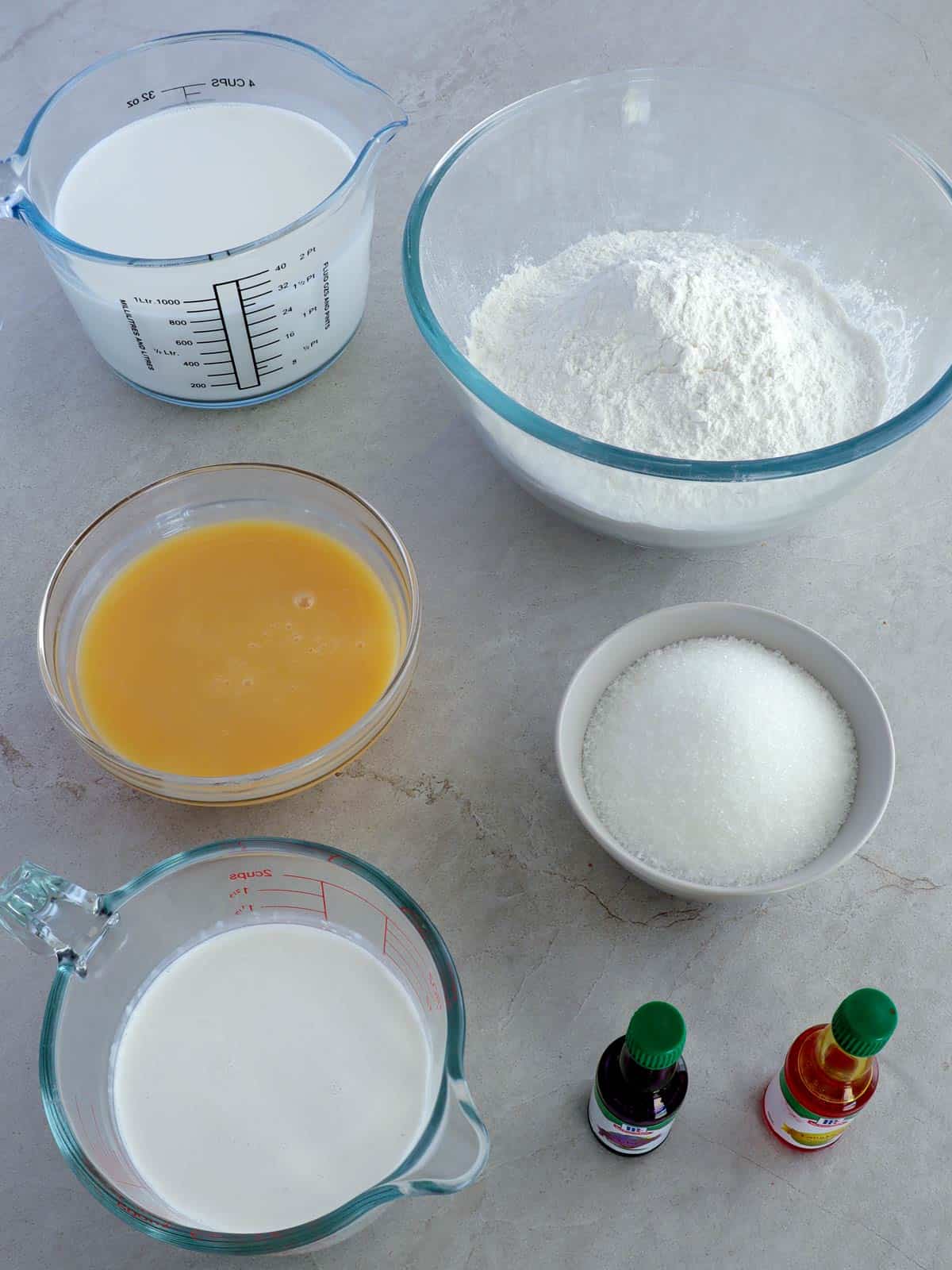
- Coconut cream - also called kakang gata, is used to make the latik topping. As it's the first extraction from grated coconut and is thicker, richer, and creamier, it will reduce quicker.
- Glutinous rice flour- Locally known as malagkit. Also called sticky or sweet rice flour, it gives the dish its signature chewy texture. The steamed kalamay is traditionally made by soaking rice grains in water overnight to soften them and then grinding them into a thick batter or galapong mixture. Using rice flour makes the process so much easier.
- Coconut milk- adds a rich, creamy taste to the batter. You can use freshly pressed or canned for convenience.
- Condensed milk- a dense liquid made from cooking down milk to remove its water content. It adds sweetness and creaminess.
- Sugar- add more or less to adjust the level of sweetness to your liking
- Flavor extracts- the recipe uses ube and langka extracts to add color and flavor.
Prepare the pan
- The rice batter is about 6 cups which fits perfectly in an 8 x 2 round baking pan. You can also use an 8 x 8 square pan with an 8-cup capacity. Or a springform pan to make releasing the sticky rice cake easier.
- Liberally grease the inner sides and bottom of the baking pan to be able to remove the sticky rice cake easily after steaming. You can also use wilted banana leaves to line the pan or parchment paper.
Sapin-sapin cooking steps
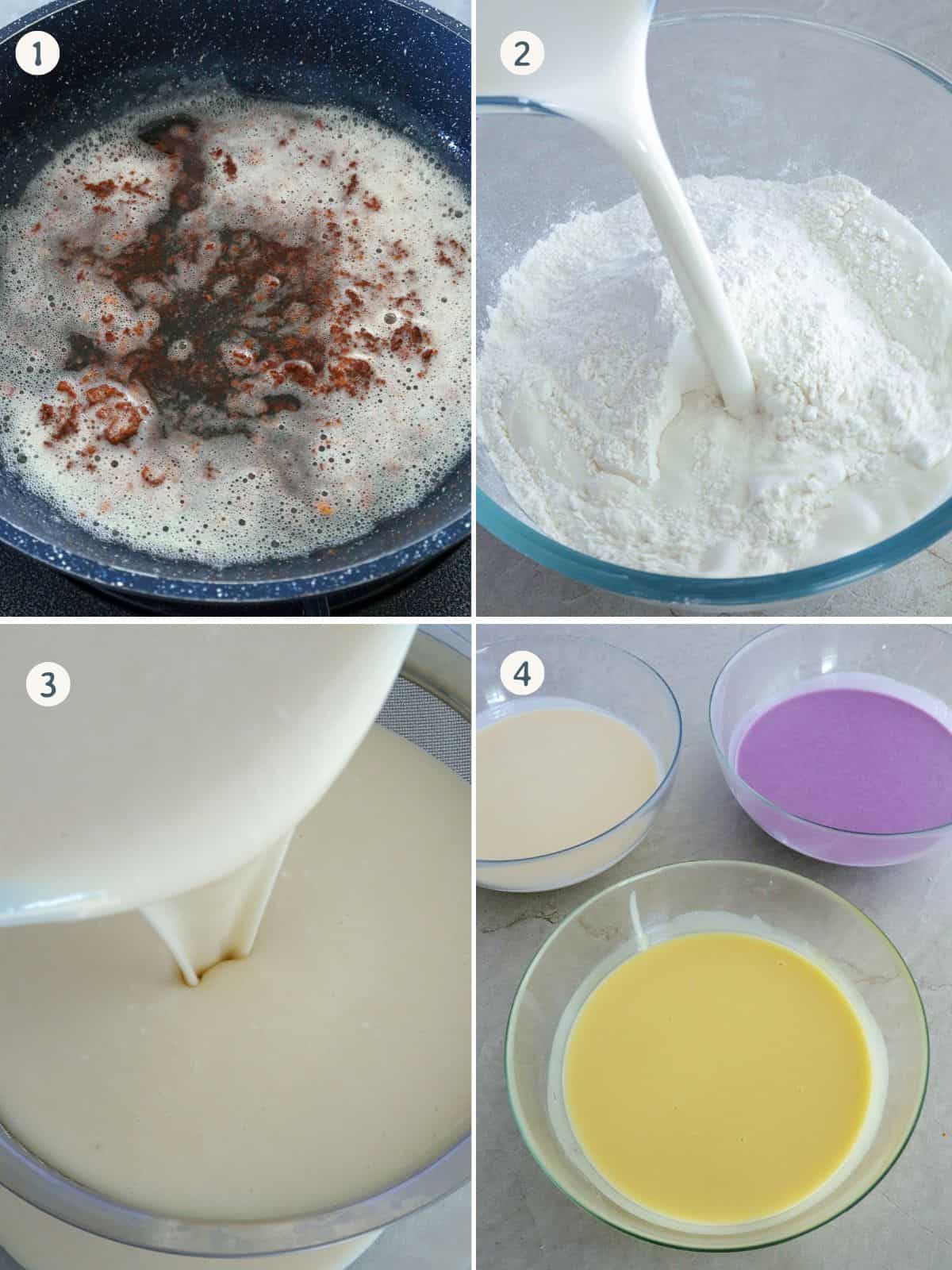
Sapin-Sapin, which means layers, is one of the easiest Filipino desserts you can make. It's so much fun watching everything come together into one colorful sweet treat! You'll be amazed at how something so gorgeous and delicious can be put together with minimal effort.
- Make the latik- check out my tutorial on how to make latik for detailed steps and tips. Drain the coconut curds well and store them separately from the coconut oil until ready to use. While you can use toasted coconut shreds instead, I urge you to make the extra effort. The latik taste so much better, and the rendered oil can be brushed on the sapin-sapin to add aroma and flavor.
- Make the batter- combine the glutinous rice flour, coconut milk, condensed milk, and sugar in a large bowl. Stir together until the sugar is dissolved and the mixture is smooth and well blended.
- Strain the batter- run into a fine-mesh sieve to remove any lumps and divide evenly into three bowls.
- Add the extracts- stir the ube in one bowl and the langka in another bowl until well dispersed, leaving the third portion plain and white. I use about 3 to 4 drops of each extract to achieve the color I like. Note that the colors of the tinted batters will be light but will deepen when steamed and cooked.
- Steam the batter- pour and steam each colored batter individually on top of each other until a toothpick inserted in the center comes out clean.
- Cool- remove the cake from the steamer and allow it to cool completely to make it easier to release from the pan. Run a knife around the sides of the pan to loosen the rice cake. Do not cover the kalamay until sufficiently cooled, as the steam will cause water puddles on the cake.
- Serve- carefully invert the pan on a wide platter and tap a few times to release the sapin-sapin onto the platter (the purple layer will now be the top layer). Liberally brush with coconut oil, sprinkle latik on top, and cut into serving portions.
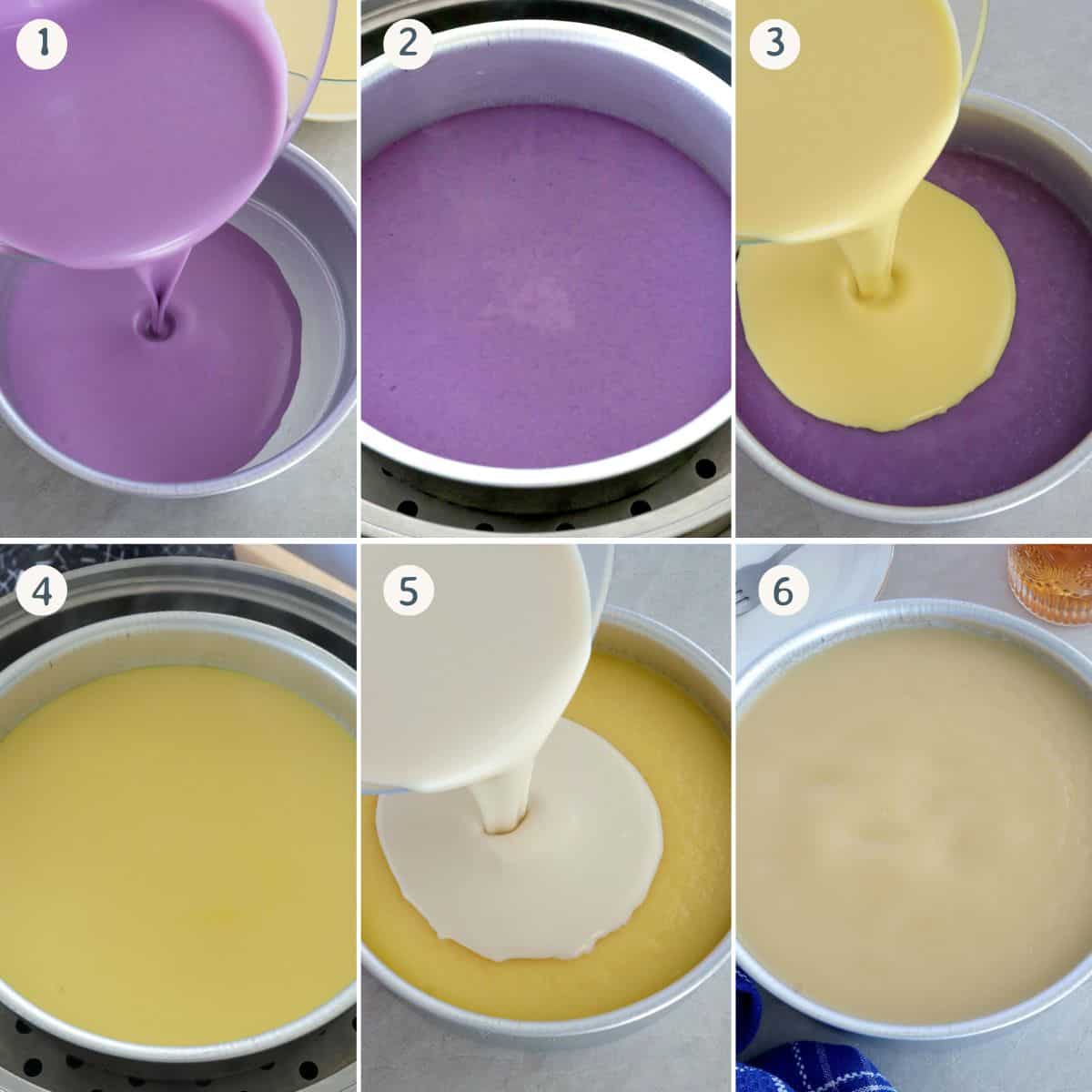
Cooking tip
To make the sapin-sapin extra special and more traditional, stir in about ½ cup of mashed cooked ube to the purple-colored mixture, ¼ cup of finely chopped jackfruit (langka) to the yellow-colored mixture, and ¼ cup chopped macapuno strips to the white mixture.
Frequently Asked Questions
What is the meaning of sapin-sapin?
Sapin-sapin literally means "sheets or layers" in the Filipino language. The name comes from the process of steaming the colored layers on top of each other.
What are the characteristics of sapin-sapin?
It's a multi-layered sticky rice cake with various flavors and coloring, such as ube and langka. This steamed kakanin is soft and chewy with a hint of coconut flavor from the use of glutinous rice flour and coconut milk. It's traditionally topped with latik or toasted desiccated coconut.
What is the history of sapin-sapin?
The word kakanin is derived from the word "kanin" and is the blanket term for Filipino delicacies made of rice. Sapin-sapin is a type of kakanin that originated in the Northern province of Abra and has spread in popularity throughout the country.
Does it need to be refrigerated?
Yes! As the kalamay is made of coconut milk, it can spoil quickly, especially in warmer weather. Allow it to cool completely before covering, as the escaping steam might cause water puddles on top of the cake. Refrigerate for up to 3 days. When ready to serve, warm up in the microwave for a few seconds to soften.

Serving suggestions
Sapin-sapin is a tasty and filling midday snack or after-meal dessert. Slice into wedges and enjoy it with coffee, tea, tsokolate, or cold sago at gulaman!
More kakanin recipes
Ingredients
For the Latik
- 1 cup coconut cream (kakang gata)
- 3 ½ cups glutinous rice flour
- 2 cans (13.5 ounces each) coconut milk
- 1 can (14 ounces) condensed milk
- 1 cup sugar
- 3 drops ube flavor extract
- 3 drops langka flavor extract
Equipment
Equipment
- Steamer
- 8x2 round pan
Instructions
- In a pan over medium heat, add coconut cream and bring to a boil. Cook, stirring occasionally until liquid starts to thicken.
- Lower heat and continue to cook. As oil starts to separate and solids begin to form, regularly stir and scrape sides and bottom of the pan to prevent from burning. Continue to cook and stir until curds turn golden brown.
- Drain latik from the oil and store in separate containers until ready to use.
- Generously brush inner sides and bottom of an 8-inch round baking pan with the oil.
- In a large bowl, combine glutinous rice flour, coconut milk, condensed milk, and sugar. Stir together until sugar is dissolved and mixture is smooth and well blended.
- Strain the batter using a fine-mesh sieve and divide evenly into three bowls.
- In one bowl, add ube extract and stir until color is well dispersed. In another bowl, add Langka extract and stir until color is well dispersed. The remaining portion will be white and plain.
- Pour ube-flavored batter into the prepared baking pan. Steam for about 10 minutes or until set and toothpick inserted comes out clean.
- Carefully pour langka-flavored batter over purple layer. Steam for about 10 minutes or until set and toothpick inserted comes out clean.
- Gently pour plain batter over yellow layer. Steam for about 10 minutes or until set and toothpick inserted comes out clean.
- Remove cake pan from steamer and allow to cool completely.
- Run a knife around the sides of the pan to loosen the rice cake. Place a wide, flat serving platter over cake pan and gently invert. Tap the pan a few times to release the sapin-sapin onto the platter (purple layer will now be the top layer).
- Liberally brush top and sides of sapin sapin with coconut oil. Sprinkle latik on top and cut the cake into serving portions.
Notes
- The rice batter is about 6 cups which fits perfectly in an 8 x 2 round baking pan. You can also use an 8 x 8 square pan with an 8-cup capacity.
- For easy removal of steamed cake, liberally grease the inner sides and bottom of the baking pan. Or use wilted banana leaves to line the pan or parchment paper.
- To make the sapin-sapin extra special, stir in about ½ cup of mashed cooked ube to the purple-colored mixture and ¼ cup finely chopped jackfruit (langka) to the yellow-colored mixture.
- Allow the kalamay to cool completely before covering, as the escaping steam might cause water puddles on top of the cake.
Video

Nutrition Information
“This website provides approximate nutrition information for convenience and as a courtesy only. Nutrition data is gathered primarily from the USDA Food Composition Database, whenever available, or otherwise other online calculators.”


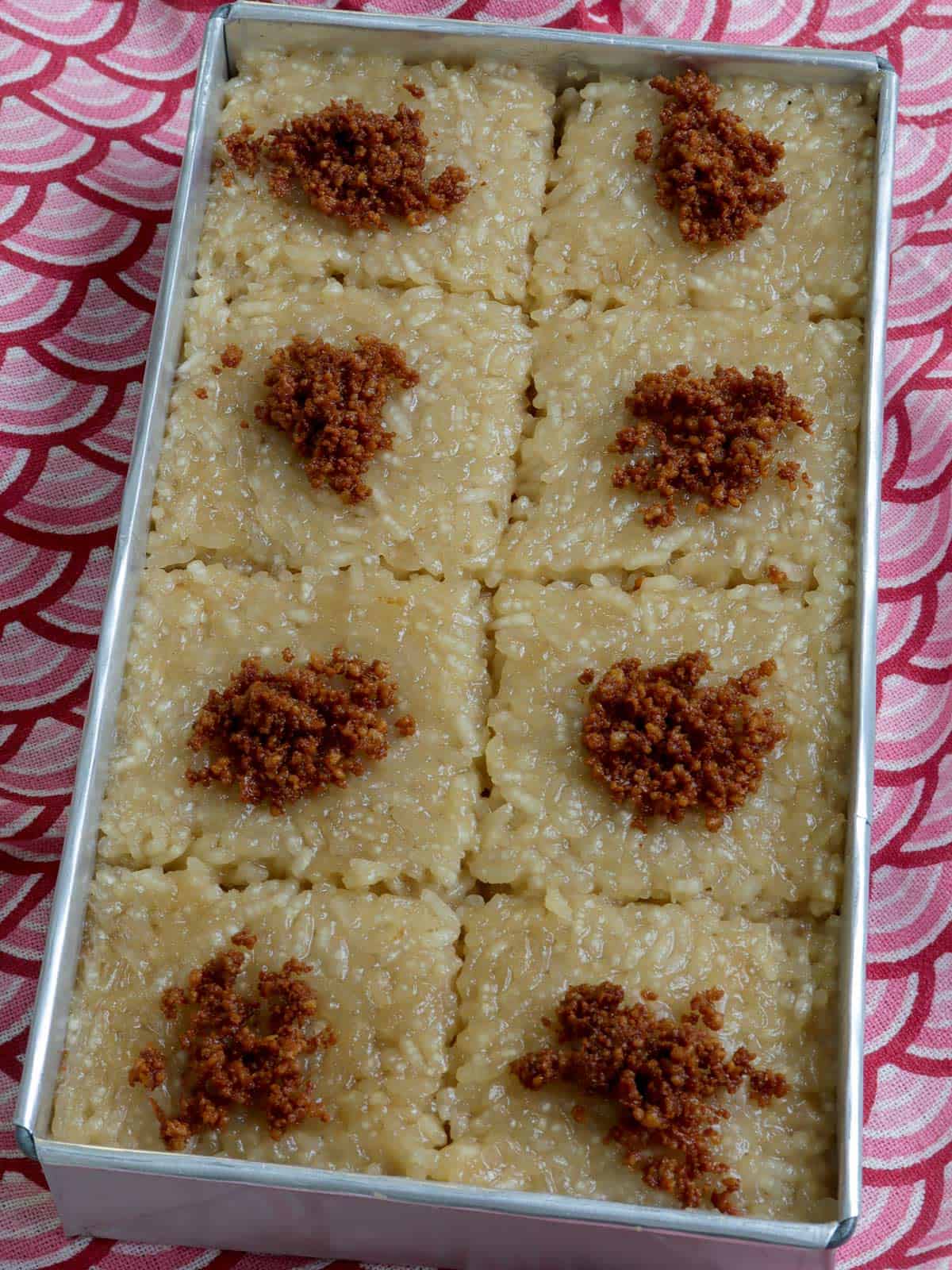

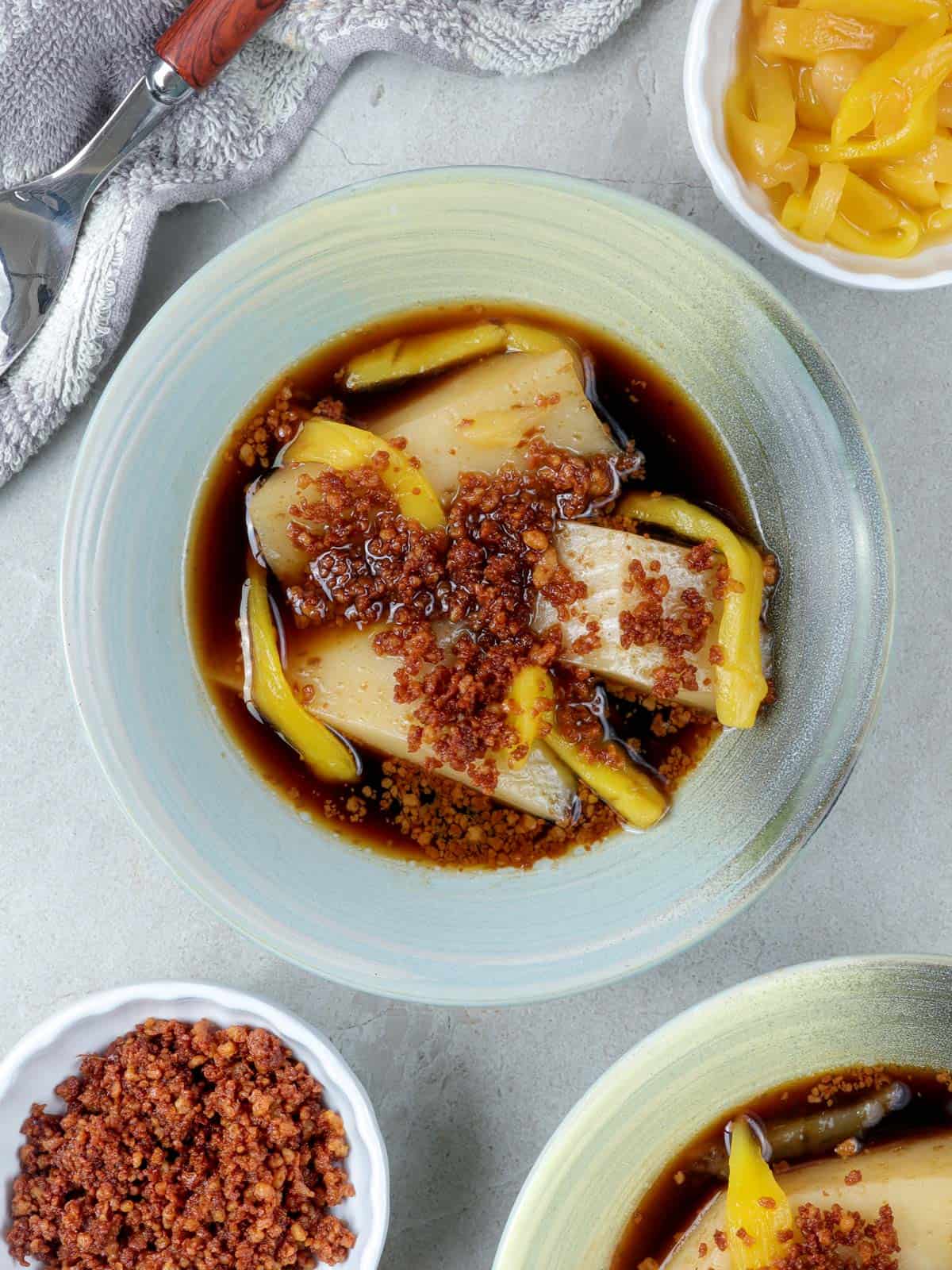

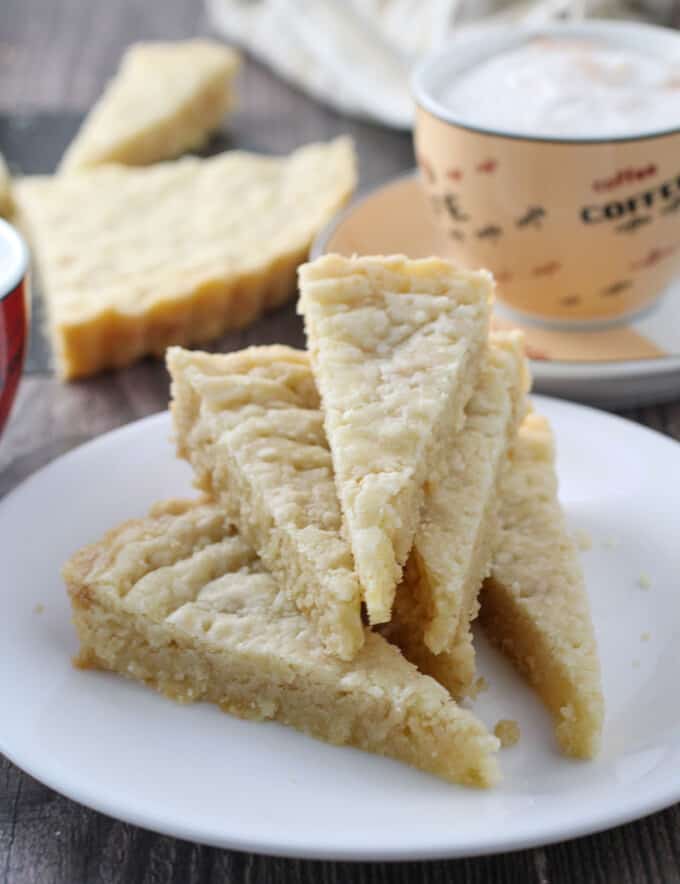

Hannah says
I made Sapin Sapin it taste delicious which is my favorite kakanin.
I love all your recipes..
God bls you and more power from Washington state here..mwuaah
Lalaine Manalo says
Thank you so much, Hannah. I am glad you are enjoying the recipes. God bless.
Charlene says
Great
Shena lim isip says
Ilove it i try this sapin sapin recipe this new year
Jasmine says
Hi! I wonder can I use mochiko sweet rice flour for this? Or does it have to be a different flour?
Jasmine says
Hi! I wonder can I use mochiko sweet rice flour for this?
Minette says
I made this for the first and they loved it. Quite easy to follow. Will definitely make it again someday!
Gigi says
This recipe doesn’t fit in 8 inch pan. It’s too much. Better to use 10 inches
Aurea says
Hello there! You mentioned about not to cover coz it will cause paddle of water in the cake. Do you mean do not cover while steaming or do not cover after it is already steamed and took it out from the steamer. Thank you! I would definitely try to make this. Sapin Sapin is one of my favorite !
Ana Marie Pauig says
So fun and so good. To enjoy and love the cooking series❤😍..I missed the cooking process of my Nanang (lola). Please do send me also the ingredients and procedures too. Thank you and God Bless🙏
Estrella says
Really good!
Helen Wilkey says
This is my first time so I will try to make it now.
Thank you,
Helen
Emelito Ersando says
Thank you po sa info
Jazmin says
This is what I’m looking for Sapin Sapin recipe I will try it now .. Thank you for sharing the recipes
Jacq says
My sapin sapin did not come out cooked even when following the instruction. I even exceeded the time alloted in the recipe. What to do with uncooked sapin sapin?